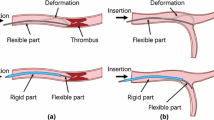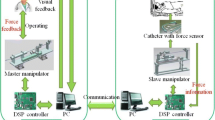Abstract
Purpose
It is difficult to manipulate a flexible catheter to target a position within a patient’s complicated and delicate vessels. However, few researchers focused on the controller designs with much consideration of the natural catheter manipulation skills obtained from manual catheterization. Also, the existing catheter motion measurement methods probably lead to the difficulties in designing the force feedback device. Additionally, the commercially available systems are too expensive which makes them cost prohibitive to most hospitals. This paper presents a simple and cost-effective master controller for endovascular catheterization that can allow the interventionalists to apply the conventional pull, push and twist of the catheter used in current practice.
Methods
A catheter-sensing unit (used to measure the motion of the catheter) and a force feedback unit (used to provide a sense of resistance force) are both presented. A camera was used to allow a contactless measurement avoiding additional friction, and the force feedback in the axial direction was provided by the magnetic force generated between the permanent magnets and the powered coil.
Results
Performance evaluation of the controller was evaluated by first conducting comparison experiments to quantify the accuracy of the catheter-sensing unit, and then conducting several experiments to evaluate the force feedback unit. From the experimental results, the minimum and the maximum errors of translational displacement were 0.003 mm (0.01 %) and 0.425 mm (1.06 %), respectively. The average error was 0.113 mm (0.28 %). In terms of rotational angles, the minimum and the maximum errors were \(0.39^{\circ }\) (0.33 %) and \(7.2^{\circ }\) (6 %), respectively. The average error was \(3.61^{\circ }\) (3.01 %). The force resolution was approximately 25 mN and a maximum current of 3A generated an approximately 1.5 N force.
Conclusion
Based on analysis of requirements and state-of-the-art computer-assisted and robot-assisted training systems for endovascular catheterization, a new master controller with force feedback interface was proposed to maintain the natural endovascular catheterization skills of the interventionalists.

















Similar content being viewed by others
References
Guiatni M, Riboulet V, Duriez C, Kheddar A, Cotin S (2013) A combined force and thermal feedback interface for minimally invasive procedures simulation. IEEE/ASME Trans Mechatron 18(3):1170–1181
Wang J, Ohya T, Liao H, Sakuma I, Wang T, Tohnai I, Iwai T (2011) Intravascular catheter navigation using path planning and virtual visual feedback for oral cancer treatment. Int J Med Robot Comput Assist Surg 7:214–224
Luan K, Ohya T, Liao H, Kobayashi E, Sakuma I (2013) Vessel bifurcation localization based on intraoperative three-dimensional ultrasound and catheter path for image-guided catheter intervention of oral cancers. Comput Med Imaging Graph 37(2):113–122
Srimathveeravalli G, Kesavadas T, Li X (2010) Design and fabrication of a robotic mechanism for remote steering and positioning of interventional devices. Int J Med Robot Comput Assist Surg 6:160–170
Aggarwal R, Black SA, Hance JR, Darzi A, Cheshire NJW (2006) Virtual reality simulation training can improve inexperienced surgeons’ endovascular skills. Eur J Vasc Endovasc Surg 31(6):588–593
Eslahpazir BA, Goldstone J, Allemang MT, Wang JC, Kashyap VS (2014) Principal considerations for the contemporary high-fidelity endovascular simulator design used in training and evaluation. J Vasc Surg 59(4):1154–1162
Desser TS (2007) Simulation-based training: the next revolution in radiology education? J Am Coll Radiol 4(11):816–824
http://www.hansenmedical.com/int/en/vascular/magellan-robotic-system/product-overview
Saliba W, Reddy VY, Wazni O, Cummings JE, David Burkhardt J, Haissaguerre M, Kautzner J, Peichl P, Neuzil P, Schibgilla V, Noelker G, Brachmann J, Di Biase L, Barrett C, Jais P, Natale A (2008) Atrial fibrillation ablation using a robotic catheter remote control system. J Am Coll Cardiol 51(25):2407–2411
Chun KRJ, Schmidt B, Köktürk B, Tilz R, Fürnkranz A, Konstantinidou M, Wissner E, Metzner A, Ouyang F, Kuck K-H (2008) Catheter ablation—new developments in robotics. Herz 33:586–589
Payne, CJ, Rafii-Tari H, Yang G-Z (2012) A force feedback system for endovascular catheterisation. In: Proceedings of the IEEE/RSJ international conference on intelligent robots and systems, pp 1298–1304, October 7–12, Vilamoura, Algarve, Portugal
Antoniou GA, Riga CV, Mayer EK, Cheshire NJW, Bicknell CD (2011) Clinical applications of robotic technology in vascular and endovascular surgery. J Vasc Surg 53(2):493–499
Das P, Goyal T, Xue A, Kalatoor S, Guillaume D (2014) Simulation training in neurological surgery. Austin J Neurosurg 1(1):1–6
Binning MJ, Siddiqui AH, Levy EI, Hopkins LN (2012) Avoiding complications during percutaneous cardiovascular interventions: What should we learn from the aviation industry? In: Complications of interventional cardiovascular procedures: a case-based Atlas. Demos Medical Publishing, pp 1–7
Cercenelli L, Marcelli E, Plicchi G (2007) Initial experience with a telerobotic system to remotely navigate and automatically reposition standard steerable EP catheters. Am Soc Artif Intern Organs J 53(5):523–529
Marcelli E, Cercenelli L, Plicchi G (2008) A novel telerobotic system to remotely navigate standard electrophysiology catheters. In: Computers in cardiology, 2008, September 14–17, Bologna, Italy, pp 137–140
Tanimoto M, Arai F, Fukuda T, Iwata H, Itoigawa K, Gotoh Y, Hashimoto M, Negoro M (1997) Micro force sensor for intravascular neurosurgery. In: Proceedings of the IEEE international conference on robotics and automation, April 20–25, Albuquerque, NM, pp 1561–1566
Negoro M, Tanimoto M, Arai F, Fukuda T, Fukasaku K, Takahashi I, Miyachi S (2002) An intelligent catheter system robotic controlled catheter system. Interv Neuroradiol 7:111–113
Tercero C, Ikeda S, Fukuda T, Arai F, Negoro M, Takahashi I (2010) Numerical comparison of catheter insertion trajectory within blood vessel model using image processing. In: 2010 international symposium on micro-nanomechatronics and human science, November 7–10, Nagoya, Japan, pp 378–383
Guo J, Guo S, Xiao N, Ma X, Yoshida S, Takashi T, Masahiko K (2012) A novel robotic catheter system with force and visual feedback for vascular interventional surgery. Int J Mechatron Autom 2(1):15–24
Thakui Y, Bax JS, Holdsworth DW, Drangova M (2009) Design and performance evaluation of a remote catheter navigation system. IEEE Trans Biomed Eng 56(7):1901–1908
Ma X, Guo S, Xiao N, Yoshida S, Tamiya T (2013) Evaluating performance of a novel developed robotic catheter manipulating system. J Micro-Bio Robot 8(3–4):133–143
Kaehler A, Bradski G (2008) Learning OpenCV. O’Reilly Media, Sebastopol
Zhang Z (2002) A flexible new technique for camera calibration. IEEE Trans Pattern Anal Mach Intell 22(11):1330–1334
Coles TR, Meglan D, John NW (2011) The role of haptics in medical training simulators: a survey of the state of the art. IEEE Trans Haptics 4(1):51–66
Moussa I, Bailey S, Colombo A (2012) Complications of interventional cardiovascular procedures: a case-based atlas. Demos Medical, New York
Acknowledgments
This research was supported partly by National High Tech. Research and Development Program of China (No. 2015AA043202) and the Kagawa University Characteristic Prior Research Fund 2012.
Conflict of interest
The authors have stated explicitly that there are no conflicts of interest in connection with this article.
Author information
Authors and Affiliations
Corresponding author
Rights and permissions
About this article
Cite this article
Guo, J., Guo, S., Tamiya, T. et al. Design and performance evaluation of a master controller for endovascular catheterization. Int J CARS 11, 119–131 (2016). https://doi.org/10.1007/s11548-015-1211-4
Received:
Accepted:
Published:
Issue Date:
DOI: https://doi.org/10.1007/s11548-015-1211-4




